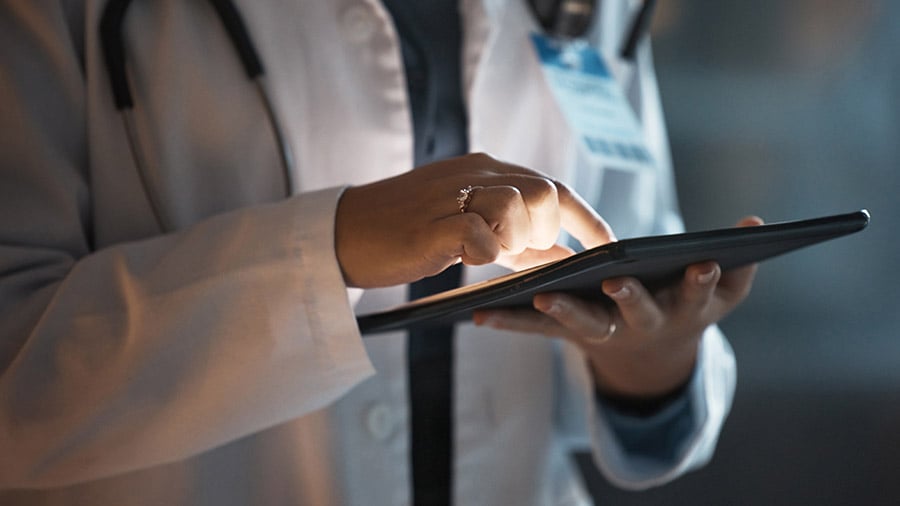Key Points:
- Evolving Healthcare Requires Dependable Cellular Connectivity: This is essential for supporting digital healthcare tools like robotic-assisted surgical procedures, telemedicine, and AI, ensuring high-speed, reliable data transfer for patient care and hospital operations一now and in the future.
- Operational Efficiency: Enhanced connectivity through 5G improves access to patient records, imaging, and clinician collaboration, leading to efficient patient management and informed decision-making.
- Security and Future Readiness: 5G networks provide superior security over WiFi, with features like advanced encryption and stronger authentication, preparing healthcare facilities for technological advancements and ensuring continuous, industry-first patient care.
Thanks to advances in digital technologies, data-driven decision-making has become a cornerstone of modern medicine, enhancing everything from patient diagnosis to treatment protocols and hospital operations.
Care coordination, robotics, telemedicine, and Electronic Health Care Record (EHR) management一not to mention AI-driven tools一are just some of the applications achieving breakthroughs in precision and efficiency.
High-speed, reliable, and secure cellular connectivity will soon be necessary to support the increasing demand for data-rich healthcare delivery. And much of that will be supported by 5G cellular technology.
Failing to invest in robust, continuous cellular connectivity today means risking falling behind in providing enhanced patient care tomorrow.
Modern Healthcare's Rising Connectivity Demands
Hospitals tend to be large, intricate facilities with high footfall. Most operate around the clock, requiring comprehensive wireless coverage for their countless services, including basics such as paging systems, mobile radios, visitor needs, and EMS communications. Additionally, several emergent trends are compounding connectivity demand, many of which are in practice today:
- The Internet of Medical Things (IoMT) devices
- Robot-assisted procedures
- Care collaboration with Web Real-Time Communication (WebRTC)
- Telemedicine
- Mobile Health (mHealth)
- Real-Time Location Systems (RTLs)
- AI & Machine Learning
Better Cellular Connectivity Improves Patient Care
As hospitals and medical facilities embrace technological advancements, the need for a robust cellular network delivering uninterrupted, fast connectivity becomes increasingly evident. It helps ensure healthcare solutions are effective and efficient in their implementation.
For example, industry-first 5G cellular technology minimizes signal interruptions, helping ensure reliable connectivity even in your building’s harder-to-reach interior locations. Enhanced speed enables data transfer up to 100 times faster than traditional cellular networks, and a more efficient cellular infrastructure reduces latency.
On the ground, this means clinicians and others can immediately access patient medical records, imaging, and test results or easily collaborate to facilitate informed decision-making and execution. This can be crucial for urgent or emergency cases where immediate access to patient data can influence outcomes.
Reliable Cellular Technology Complements WiFi
While encrypted WiFi is essential in healthcare settings to meet HIPAA regulations and other compliance requirements, capacity or performance may not be sufficient. Range limitations, bandwidth constraints, interference issues, and cyber events can disrupt healthcare delivery and its many adjacent activities.
Robust cellular networks enhance the aggregate communication infrastructure within a healthcare setting, helping ensure quality service and care delivery 24/7/365. Relatedly, 5G connectivity can provide greater security features than even encrypted WiFi for the following reasons:
- Advanced encryption eclipses that used by most WiFi networks.
- Stronger authentication protocols than WiFi which reduce the risk of unauthorized access.
- Controlled access to help reduce the risk of attack versus public WIFi networks with varying levels of security.
- Network slicing, a 5G architectural feature enabling multiple levels of security protocols for different data types.
- Lower localized interference or attack risk originating at a localized router or access point.
Cellular Solutions to Prepare You for Now & Later
The necessity for robust cellular infrastructure to improve capacity and utility and fully leverage technological potential at scale is clear. However, as cellular connectivity evolves, the shorter range and weaker signals characteristic of 4G, 5G, and next-gen technologies have to work harder to penetrate hospital walls and other barriers一a challenge that will only worsen over time, and one carriers are not prepared to address.
As such, best practices call for future proofing within facilities now to ensure access to the promises that state-of-the-art cellular networks can provide and quality healthcare will require.
This forward-thinking approach starts with Implementing Distributed Antenna Systems (DAS), offering best-in-class reliability and scalability to help ensure your facility has the wireless coverage essential for delivering the functionality your team needs and the care your patients deserve.
- DAS is engineered for in-building cellular, public safety, and personal communications service (PCS) coverage, boosting cellular signals throughout a building across different platforms, frequencies, and carriers.
- DAS also offers adaptability, making it easier to upgrade to emerging technologies, such as 5G, when the time is right.
- It’s the go-to connectivity solution for multi-carrier, multi-frequency coverage in hospital settings.
Embracing Cellular Connectivity for a Resilient Healthcare Future
As healthcare continues to advance, the hospitals that invest in and prioritize better cellular infrastructure will be best positioned to enhance patient care and leverage the full spectrum of evolving digital healthcare solutions.
This is where Airtower can help. With our deep understanding of the healthcare industry and its distinct connectivity requirements, we are uniquely positioned to guide healthcare facilities and their IT teams through these crucial transitions and beyond.
Specializing in connectivity-as-a-service, Airtower not only designs, builds and deploys industry-first cellular networks but can provide ongoing monitoring and maintenance as a subscription for up to 10 years. Our suite of customized solutions streamlines the upgrade process, eliminating the need to manage multiple vendors and negotiate carrier contracts.
As a long-term connectivity partner in the healthcare space, Airtower is the go-to provider for robust cellular networks that support the growing demands of the industry, ensuring facilities are well-equipped for both current needs and future innovation.
Airtower Networks provides customized solutions such as cellular, private LTE, Public-Safety DAS, and more for seamless in-building connectivity that helps improve cost, quality, and outcomes for your healthcare setting. Learn more about our healthcare offerings, or contact us today to commence your connectivity journey!
Subscribe to the Airtower Networks Blog
Get emailed articles, guides, and updates.




